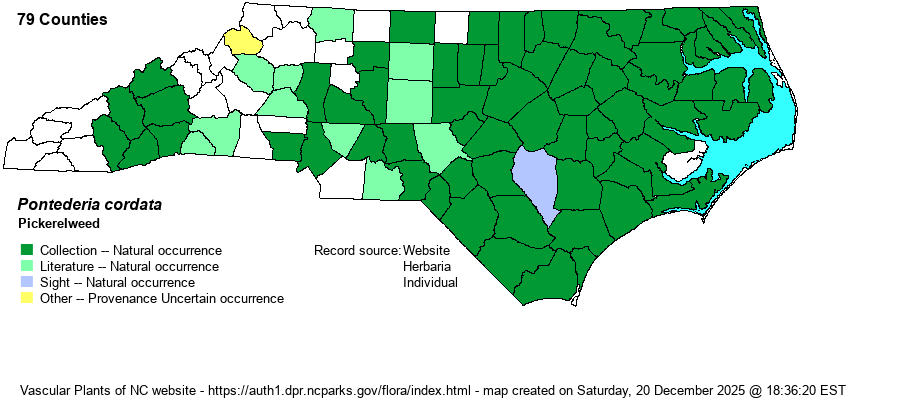| Author | L. | |
| Distribution | While the extremes of this species are certainly different in leaf shape, there is a complete series linking the extremes as viewed in eastern North America. Therefore, P. cordata var. lancifolia is not recognized here by the website editors, despite it being listed by Weakley (2022). The full species occurs throughout the Coastal Plain and the eastern parts of the Piedmont. It is spotty in occurrence in the western and central Piedmont. However, this species is perhaps planted by staff at some parks in the state at man-made lakes and ponds, and the "increase" in western Piedmont records as seen by iNaturalist photos may be somewhat of an un-natural spread. It may be legitimately absent in the northern Mountains, at least as a native species.
This is a very widespread species across eastern North America. It ranges north to Canada and south to the Gulf Coast from southern FL to eastern TX. It is scarce and local in the Appalachians and the Ohio and Tennessee river drainages.
| |
| Abundance | Common over nearly all of the Coastal Plain. Fairly common to locally common in the eastern Piedmont, but mostly uncommon and local in the rest of the Piedmont. Rare in the Mountains. | |
| Habitat | This is an aquatic/wetland species that grows mainly along pond and lake shorelines and in freshwater marshes. It also grows in canals and larger ditches. |
| Phenology | Blooms from May into October, and fruits shortly after blooming.
| |
| Identification | This is a well-known plant to most people, owing to its unique spike of flowers, more so than the leaves. It is a rather robust plant, growing to about 2-2.5 feet tall, with one or two very large and cordate leaves along the lower part of the stem. Each leaf blade is about 6 inches long and about 3 inches wide, with a tapering tip and a heart-shaped base; they are stiffly erect and thus carried well above the water surface owing to their long petioles (of up to 1 foot long). The flowering scape covers the top 4-6 inches of the stem, and the spike consists of a dense cluster of bright blue flowers, each about 1/2-inch across. These spikes are favored nectar sources for bees, butterflies, and other insects. As with most similar aquatic species, Pickerelweed grows in dense mono-culture stands along pond margins, canal banks, and other bodies of fresh water. | |
| Taxonomic Comments | Weakley (2022) lists two varieties present in NC -- the nominate var. cordata and also var. lancifolia. As mentioned above, B. Sorrie (one of the website editors) has reviewed enough specimens of both taxa to conclude that taxonomic distinction of these is not merited.
| |
| Other Common Name(s) | None | |
| State Rank | S5 | |
| Global Rank | G5 | |
| State Status | | |
| US Status | | |
| USACE-agcp | OBL link |
| USACE-emp | OBL link |

